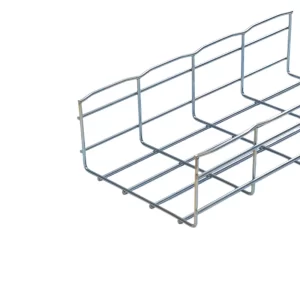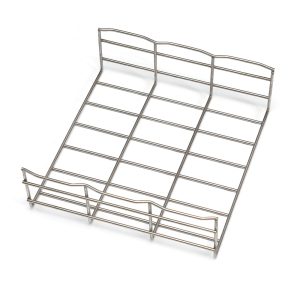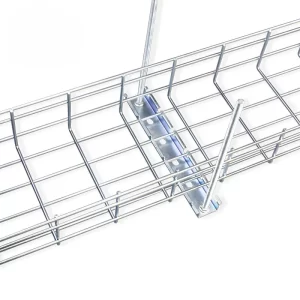In the world of electrical installations and cable management, choosing the right type of cable tray is crucial for ensuring the safety, efficiency, and longevity of the system. Wire mesh cable trays have emerged as a popular choice in many applications due to their unique features and benefits. In this article, we will explore when to use wire mesh cable trays and why they are a suitable option in specific situations.
Cable trays are used to support and organize electrical cables, protecting them from damage and facilitating easy access for maintenance and troubleshooting. There are several types of cable trays available, each with its own characteristics and advantages. Wire mesh cable trays, in particular, offer a combination of strength, ventilation, and flexibility that makes them suitable for a wide range of applications.

Features of Wire Mesh Cable Trays
1. Ventilation
One of the key features of wire mesh cable trays is their excellent ventilation. The open mesh design allows air to circulate freely around the cables, preventing heat buildup and reducing the risk of overheating. This is especially important in applications where large amounts of electrical power are being transmitted or where cables are densely packed.
The ventilation provided by wire mesh cable trays also helps to dissipate moisture, reducing the risk of corrosion and damage to the cables. This makes them ideal for use in damp or humid environments.
2. Visibility
The open mesh structure of wire mesh cable trays provides excellent visibility of the cables. This makes it easy to identify and locate specific cables, which is essential for maintenance and troubleshooting. Visibility also allows for quick inspection of the cables for signs of damage or wear, enabling timely repairs or replacements.
In addition, the visibility of wire mesh cable trays can enhance the aesthetic appeal of an installation, as the cables are not hidden behind solid panels. This can be particularly important in areas where the cable management system is visible to the public or in high-end commercial and industrial settings.
3. Strength and Durability
Wire mesh cable trays are typically made from steel or stainless steel, which provides high strength and durability. They can support heavy loads of cables without sagging or deforming, ensuring the stability and safety of the installation.
The mesh design also allows for some flexibility, which can be beneficial in applications where there may be vibrations or movement. Wire mesh cable trays can absorb these forces without transferring them to the cables, reducing the risk of damage.
4. Easy Installation and Modification
Wire mesh cable trays are relatively easy to install compared to some other types of cable trays. They can be cut to size on-site using simple tools, and they can be joined together using clips or fasteners. This makes it easy to customize the length and configuration of the cable tray to fit the specific requirements of the installation.
In addition, wire mesh cable trays can be easily modified or expanded as the needs of the installation change. New cables can be added or existing cables can be relocated without the need to disassemble the entire cable tray system.

When to Use Wire Mesh Cable Trays
1. High-Voltage Applications
Wire mesh cable trays are often used in high-voltage applications where the risk of heat buildup is a concern. The ventilation provided by the open mesh design helps to dissipate the heat generated by high-power cables, reducing the risk of overheating and fire.
In addition, the strength and durability of wire mesh cable trays make them suitable for supporting heavy high-voltage cables. They can withstand the mechanical stresses and vibrations associated with high-power electrical systems.
2. Data Centers and Server Rooms
Data centers and server rooms require efficient cable management to ensure the reliability and performance of the IT equipment. Wire mesh cable trays are a popular choice in these applications due to their ventilation, visibility, and ease of installation.
The ventilation provided by wire mesh cable trays helps to keep the cables cool, reducing the risk of overheating and equipment failure. The visibility of the cables makes it easy to identify and troubleshoot any issues, while the easy installation and modification allow for quick changes and expansions as the data center grows.
3. Industrial Environments
Industrial settings often involve harsh conditions such as dust, moisture, and vibrations. Wire mesh cable trays are well-suited for these environments as they are durable and can withstand the rigors of industrial use.
The ventilation and visibility of wire mesh cable trays are also beneficial in industrial applications. The ventilation helps to prevent dust and moisture from accumulating on the cables, while the visibility allows for easy inspection and maintenance.
In addition, wire mesh cable trays can be used to route cables in areas where there is limited space or where cables need to be protected from physical damage. The open mesh design allows for easy access to the cables, while the strength of the tray provides protection against impacts and abrasions.
4. Outdoor Installations
Wire mesh cable trays can be used in outdoor installations where cables need to be protected from the elements. The open mesh design allows for air circulation, preventing moisture buildup and reducing the risk of corrosion.
In addition, wire mesh cable trays can be coated with anti-corrosion materials to further enhance their durability in outdoor environments. They can also be installed on poles or brackets to provide support and protection for cables in areas where underground installation is not possible.
5. Retrofit Projects
Wire mesh cable trays are often used in retrofit projects where existing cable management systems need to be upgraded or expanded. The easy installation and modification of wire mesh cable trays make them a convenient choice for these types of projects.
In retrofit projects, wire mesh cable trays can be installed over existing cables without the need to remove them. This saves time and reduces disruption to the ongoing operations of the facility.

Considerations When Using Wire Mesh Cable Trays
1. Cable Compatibility
Before using wire mesh cable trays, it is important to ensure that they are compatible with the types of cables being installed. Some cables may require additional protection or support, which may not be provided by wire mesh cable trays.
Consider the size, weight, and insulation requirements of the cables when choosing a cable tray. Make sure that the tray can support the load of the cables and provide adequate protection against mechanical damage and environmental factors.
2. Fire Protection
In some applications, fire protection may be a concern. Wire mesh cable trays may not provide the same level of fire resistance as solid panel cable trays. Consider using fire-rated cables or installing additional fire protection measures such as fire stops or fire-rated enclosures.
Check with local building codes and regulations to determine the fire protection requirements for your installation. Make sure that the cable tray system meets these requirements to ensure the safety of the facility.
3. Load Capacity
Wire mesh cable trays have a specific load capacity, which should be considered when determining the number and size of trays needed for an installation. Overloading the trays can lead to sagging or deformation, which can damage the cables and compromise the safety of the system.
Consult the manufacturer’s specifications for the load capacity of the wire mesh cable trays and calculate the total weight of the cables to be supported. Make sure that the trays can handle the expected load without exceeding their capacity.
4. Aesthetics
While wire mesh cable trays offer many practical benefits, their open mesh design may not be suitable for all applications from an aesthetic perspective. Consider the visual impact of the cable tray system on the surrounding environment and choose a design that is appropriate for the location.
In some cases, wire mesh cable trays can be painted or coated to match the color scheme of the installation or to blend in with the surrounding architecture. This can help to improve the overall appearance of the cable management system.
Wire mesh cable trays are a versatile and practical choice for many cable management applications. Their ventilation, visibility, strength, and ease of installation make them suitable for a wide range of environments, including high-voltage applications, data centers, industrial settings, outdoor installations, and retrofit projects. However, it is important to consider the specific requirements of each application and ensure that wire mesh cable trays are compatible with the cables being installed and meet the necessary safety and regulatory standards. By carefully evaluating the needs of your installation and choosing the right cable tray system, you can ensure the efficient and reliable management of your electrical cables.

